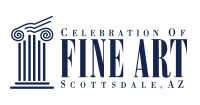Pablo Picasso once said, “Neither is there figurative and non-figurative art. All things appear to us in the shape of forms. Even in metaphysics ideas are expressed by forms. Well then, think how absurd it would be to think of painting without the imagery of forms. A figure, an object, a circle, are forms; they affect us more or less intensely.”
Indeed, forms of all kinds impact each of us differently, but the form of the human figure is one that has held an undeniable and captivating power over artists and art lovers alike since the beginning of time. In this Art Discovery, three talented figurative artists share what draws them to represent the human form on canvas and in bronze.
Contemporary figurative artist Priscilla Nelson has been painting for four decades, experimenting with many mediums and subject matters. But her personality is such that she needs to be challenged by every work she undertakes. She finds that there is nothing quite so daunting—and thrilling—as portraying the human figure.
“I’m drawn to paintings that evoke emotion or tell a story and therefore that’s what I love to paint,” she said. “I paint until I feel like I capture that emotion.”
Priscilla also explained how her obsession with water has become an integral part of her work –– often getting her models into the water to capture the interplay of light and water on their skin.
Like Priscilla, British contemporary bronze sculptor Levi Selway developed a love for art at an early age, which he credits his mom for transferring to him. Though that love would stick with him, as he thought about viable career options, he veered away from art, instead opting for medical school. But it wasn’t long before he realized he couldn’t deny his true passion –– art.
Following the encouragement of his wife, Levi attended an open studio course at a local foundry –– and it was that encounter that would where he found his true calling.
“When I walked into that studio and saw all these clay figures, I had sort of a ‘coming home’ experience,” he said. “I just knew that was the missing element and for the past nine years, I’ve been pursuing the figure.”
He is drawn to sculpt the figure because of the ancestral allure of the medium. He is inspired by the long tradition of figurative representation, from cave paintings dating back 37,000 years to the Renaissance masters, whose work he fell in love with during travels to Italy.
As a species, he notes, we are captivated by representing ourselves. And mastering the representation of the complexities of the figure and our human anatomy is a lifelong pursuit.
Aiden Kringen was drawn to create abstract work in his youth, but he has gravitated toward the figure as he has grown older. He seeks beauty through the figure, and by noticing the planes that define the form and the areas of light and shadow, he has developed a unique, fractured aesthetic.
“I started to trace the planes of the figure to organize it for myself and that’s when I developed that style of fragmentation and fractured aesthetic,” Aiden said. “I’m constantly trying to find that balance between pure abstraction and realism.”
Aidan cites the work of John Singer Sargent, another figurative artist well-known for his ability to capture dramatic light and movement in his portraits, as a significant source of inspiration.
Interestingly, both Priscilla and Levi share something else in common beyond art: a history with the medical field. Both artists first considered becoming doctors before transitioning to figurative art. The respect and awe for the human form is a common thread in both fields.
To learn more about how our mixed panel approaches capturing the depth and beauty of the figure, watch the full Art Discovery below. And to learn even more about our featured artists, check out the following links:
Priscilla Nelson:
Artist page
Video interview
Artist shop
Levi Selway:
Artist page
Artist shop
Aiden Kringen:
Artist page
Artist shop

